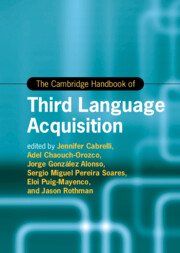Book contents
- The Cambridge Handbook of Third Language Acquisition
- Cambridge Handbooks in Language and Linguistics
- The Cambridge Handbook of Third Language Acquisition
- Copyright page
- Contents
- Figures
- Tables
- Contributors
- Introduction Multilingualism
- Part I Theoretical Approaches to L3/Ln
- Part II L3/Ln across Linguistic Domains
- Part III Becoming and Staying Multilingual at Different Ages
- Part IV L3/Ln in Action
- Part V L3/Ln and Cognition
- 20 Multilingualism and Cognitive Control in the Brain
- 21 Multilingualism and Cognitive Reserve
- 22 The Effects of Multilingualism on Brain Structure, Language Control and Language Processing
- 23 Mechanisms of Cognitive Aging in Multilingualism
- 24 Multilingualism and Language Impairment
- Part VI Research Methods in L3/Ln
- Index
- References
22 - The Effects of Multilingualism on Brain Structure, Language Control and Language Processing
Insights from MRI
from Part V - L3/Ln and Cognition
Published online by Cambridge University Press: 13 July 2023
- The Cambridge Handbook of Third Language Acquisition
- Cambridge Handbooks in Language and Linguistics
- The Cambridge Handbook of Third Language Acquisition
- Copyright page
- Contents
- Figures
- Tables
- Contributors
- Introduction Multilingualism
- Part I Theoretical Approaches to L3/Ln
- Part II L3/Ln across Linguistic Domains
- Part III Becoming and Staying Multilingual at Different Ages
- Part IV L3/Ln in Action
- Part V L3/Ln and Cognition
- 20 Multilingualism and Cognitive Control in the Brain
- 21 Multilingualism and Cognitive Reserve
- 22 The Effects of Multilingualism on Brain Structure, Language Control and Language Processing
- 23 Mechanisms of Cognitive Aging in Multilingualism
- 24 Multilingualism and Language Impairment
- Part VI Research Methods in L3/Ln
- Index
- References
Summary
This chapter reviews a small but growing body of research that examines neuroplasticity stemming from multilingualism, specifically discussing some similarities and differences in brain structure and function stemming from in processing three or more languages, as a departure from bilingualism. The evidence comes from studies using magnetic resonance imaging to examine patterns of grey matter structure across cortical and subcortical regions, and aspects of white matter microstructure. This chapter also highlights the functional activation and temporal information of various processes that occur during language processing in multilinguals, while accounting for the influence of language background factors. It then discusses conflicting and agreeing evidence in the literature and attempts to consolidate the findings with suggestions based on contemporary frameworks such as the Dynamic Restructuring Model (Pliatsikas, 2020). In closing, the chapter highlights gaps and pose questions for future research directions in the field of multilingualism and neuroplasticity.
- Type
- Chapter
- Information
- The Cambridge Handbook of Third Language Acquisition , pp. 577 - 605Publisher: Cambridge University PressPrint publication year: 2023

